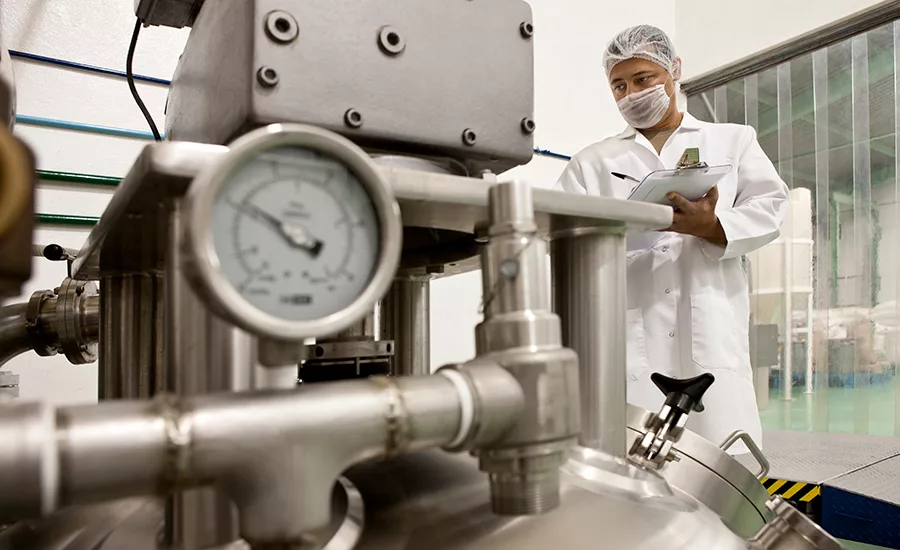To Buy or Not to Buy? Considerations When Purchasing Used Food Processing Equipment

MiguelMalo/E+ via Getty Images
When buying equipment for a food processing facility or commercial kitchen, it is ideal to purchase new equipment that is designed for the specific product, processing use, and processing capacity at the facility. However, in many cases this equipment may be cost-prohibitive, or the exact type of equipment may not be readily available, and so used equipment may need to be purchased instead.
Numerous ways exist to procure used equipment. Supply houses, for example, offer food processing and commercial kitchen equipment. Some food processing facilities sell their own used equipment. Also, several online auctions specialize in food processing supplies and equipment. Some equipment is advertised and sold via general classified ads, on Craigslist, on social media marketplace sites, and via other online resources.
Some businesses and third parties have knowledge of the equipment they are selling, but sometimes a selling platform may not understand the nature of the equipment they are advertising. Consequently, the responsibility for understanding what is being purchased falls on the buyer. If the used equipment is not clearly understood and verified, then it could end up costing a facility more money in the long term.
Prior to buying used food processing equipment, it is important to first analyze the business case for the purchase. What is the purpose of the equipment, and how will it affect the business? Will the equipment allow for an increase in throughput, bring about an increase in efficiency, encourage an expansion in customer count or base, enable the manufacture of another product, or decrease any quality or safety defects present in the current operation? Also, it is important to ensure that no other bottlenecks in the processing line will prevent the achievement of the goals of purchasing the equipment. For example, if a larger piece of equipment is purchased but another piece of equipment upstream or downstream cannot accommodate the new flowrate, then the goals may not be met. In addition, customer analyses must be completed for both the process workflow and for the business as a whole. Ensure that the equipment will meet the needs of both the process line operation and the overall objectives of the business.
To ensure that the used equipment will prove a benefit and not a liability, many items must be considered prior to purchase (see Table 1). Not all of the following items will be appropriate for all equipment; however, this list may be used as a general checklist of items to consider before bidding or buying on "new to you" equipment.
Table 1: Items to Consider When Purchasing Used Food Processing Equipment
|
Item to Consider |
Comments |
|
Size considerations |
Bigger is not always better. Think "Goldilocks and the three bears"—too small may not help with the goals of buying the equipment, but too big can challenge the processing system, and the increase will not be fully utilized. |
|
Are the materials appropriate? |
What materials is the equipment constructed from, and are they appropriate for the facility? Think of how pH can affect different materials, the risk of foreign material to product mix and suitability, and other considerations. |
|
What are the utilities needed to operate? |
What is the energy source for the equipment? What are its power requirements (single phase, three phase, 120 V, 240 V, 480 V)? Does it need steam (how many lbs/hp-hr)? Is product conveyed via pneumatics (at what cfm)? Does the equipment require ventilation or HVAC? Will the equipment create any condensation or temperature changes that will need to be mitigated? |
|
What are the controls needed to operate? |
What kind of automation does the unit require? Are the control systems and knowledge available to operate it? |
|
Can the equipment be cleaned? |
Is the equipment designed to be cleaned in place or cleaned out of place? Are the necessary tools and equipment available to clean it? |
|
Size and location in the processing facility |
What kind of footprint will this equipment create in the facility? Is room available to accommodate it? Will the new equipment cause any processing or food safety issues (e.g., placing a steam tunnel in front of a refrigerator/freezer)? Will the equipment be placed in a different room or an area requiring the transport of goods, thus resulting in wasted motion or over-transportation? If so, how will that affect the food safety traffic pattern in the facility? |
|
Maintenance |
What kinds of repair, preventative maintenance, or breakdowns can occur with this equipment? Is the necessary expertise available in-house to address them? If not, can someone who does have the knowledge to maintain or repair the equipment be procured? What spare parts should be kept in stock, and what is the availability of spare parts for the unit? |
|
Calibrations |
Does the equipment have instrumentation that needs to be calibrated? Does someone in the facility have the ability to complete accuracy checks and calibration of that instrumentation—especially if it impacts food safety or machine operation? |
|
What are the installation costs? |
Is the unit essentially plug-and-play, or must it be professionally installed? If the latter, what is the cost of installation, and how will that impact the overall purchase price or timeline for the equipment? |
|
Employee safety aspects |
Do any safety features need to be installed? Does the unit have all the necessary safety features for the specific application for which it is intended? If the equipment is older, it may have been manufactured prior to present safety regulations, or some safety features may have been removed or lost. Also, the equipment may have been manufactured in another country with different safety regulations. It is important to complete a job safety analysis for each piece of equipment to protect employees and operators. |
|
Current condition |
The condition of the equipment should be visually inspected for niches, holes, cracks, and crevices. Are there any missing bolts, clamps, or other parts? What is the condition of the parts that wear (e.g., belts, sprockets, bearings, gearboxes, or other moving parts)? Are all the welds smooth and crack-free so that they meet sanitary welding criteria? Examine oils and lubricants to check for signs of age, discoloration (milky white), or grittiness that could indicate an issue. Listen for any abnormal sounds (e.g., thumbs, grinds). |
|
Prior use |
What was the prior use of the equipment? What is the age of the equipment? Does it come with any user manuals or SOPs? Are previous maintenance records available? |
|
Warranty or guarantee |
Is the seller willing to offer a warranty or some sort of guarantee that the equipment will work as described? |
|
Seller reputation |
Although not directly related to the equipment, is the seller reputable? Do you feel comfortable doing business with the seller? |
|
Food safety plan considerations |
Have discussions taken place with the food safety team about the equipment and how it would impact the food safety plan? |
Used equipment can be a great asset to a food processing facility and help meet a number of goals. However, it is imperative to understand the exact needs of the facility by analyzing the current equipment and future goals of the facility. It is important to ensure that the equipment will meet those goals and will fit with existing processing needs and food safety considerations, instead of detracting from them or costing more in the long term. Good luck, and good purchasing!
Looking for quick answers on food safety topics?
Try Ask FSM, our new smart AI search tool.
Ask FSM →








